$230,431.
That’s the amount Chris Prendergast raised for his attachable electric guitar amplifier, JamStack, through crowdfunding.
And it only took him 6 months.
But let’s back up a bit…
JamStack is a project 4 years in the making.
- The first thing Chris did was rig up an ugly proof-of-concept prototype to solve his own problem - and it worked really well.
- He kept it to himself, until one day he brought it to a party, began using it, and got great feedback from his musician friends.
- This gave him the validation he needed to start looking into what it would take to fully develop this into a product.
- He met with a local design firm, which sealed the deal for him - they loved it and wanted to partner.
At this point, Chris didn’t think much of the impact JamStack could have.
He certainly couldn’t predict that 12 months after his conversation with a design firm he would have hundreds of new customers and over a quarter million dollars in pre-orders before he had even fully developed the JamStack.
But it happened.
All thanks to crowdfunding.
In just a few short months, Chris turned his brilliant idea and hideous prototype into a product that customers wanted even before it was finished.
And the best part is: the same thing can happen for you.
As long as you have a few key ingredients and the right plan, you can successfully get your project funded with crowdfunding too.
To help you out, I’ll show you what it takes to make it in the crowdfunding world and how to catapult your project from ugly prototype to a quarter million in pre-orders just like how I helped Chris.
Now, I want to be clear on something: this is not an everyone’s a winner strategy. Not everyone gets a trophy here. But, given the right project and the strategy I outline today, success is possible with crowdfunding.
Grab Your Free Product Launch Toolkit
Before you dive into any new venture, it helps to get the basics down.
Why Crowdfund in the First Place?
Having an idea is great, but it’s only the first step.
From there, you need to figure out how to actually develop the first prototype, who will manufacture future versions of the product, and how to tackle order fulfillment.
Unfortunately, these things don’t come for free.
And since most of us aren’t swimming in trust funds, we usually turn to the following money-lending options:
- Ask friends/family/your boss for financial backing
- Find an angel investor willing to take your project on
- Get a loan from the bank
- Remortgage your house
While these routes can certainly get you some funding, they’re also putting you into thousands of dollars of debt all before you even capture one paying customer. Talk about risky.
What if there was a way to raise enough money to design, manufacture, and sell your product without you having to take out a loan or go into debt?
Welcome to crowdfunding.
With this option, you can raise capital for your new project by tapping into a huge group of investors.
And these eager backers, as they’re known, will help you validate and fund your idea before you sink thousands of dollars into manufacturing your project. So you won’t need to sell a kidney or owe your grandmother a small fortune.
It’s a less risky option, but, it also comes with a ton of competition. After all, who wouldn’t want to fund their next big idea without going into debt?
So, to be clear, you’re joining millions of others hoping to achieve the same thing.
Luckily, success is possible otherwise I wouldn’t have spent my time writing this guide.
The next thing you need to know is where to actually go to crowdfund.
The Two Most Popular Platforms
Two of the most popular platforms include Kickstarter and Indiegogo.
As of writing this, Kickstarter boasts:
- 125,996 projects have been funded on their platform
- $3.1 billion dollars have been pledged
- 13 million backers of which 4 million are repeat backers
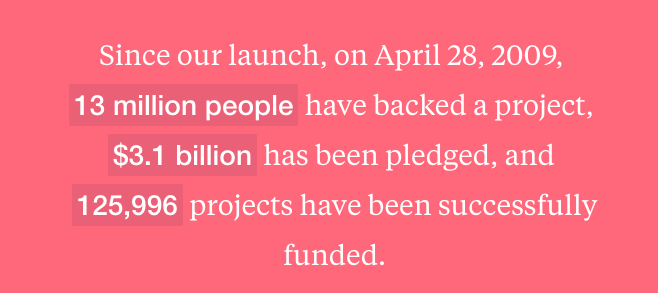
Indiegogo comes up slightly lower, but still just as powerful:
- In total, their project count exceeds 650k (they don’t mention how many were funded)
- $1 billion has been raised
- 11 million backers have contributed so far
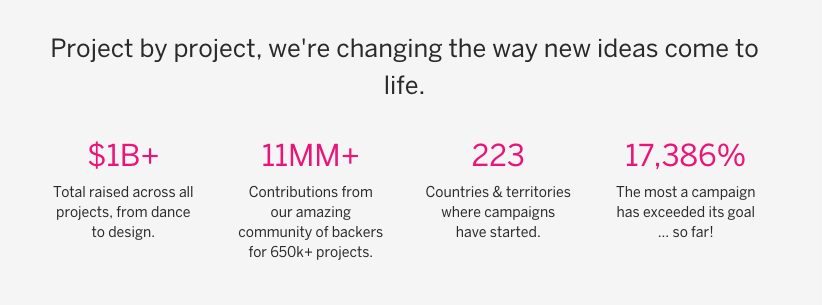
In both cases, these platforms exist as a way to match your project with customers, also known as backers.
Unlike regular consumers, backers pre-order products before they’re even built. This gives entrepreneurs like you the capital to create the product without having to invest a dime of your own money.
The backers then just sit tight while you do the heavy lifting.
Now, to raise this capital, you need to create a crowdfunding campaign and set a funding target.
A funding target is a set amount that must be met in order for your project to be successfully funded.
If your project meets or exceeds your goal, the money is transferred right to your bank account so you can get to work.
An example of this in action would be TappLock. I had initially set a goal of $40,000 to pay for tooling, however, we went on to raise $329,236. So the money was transferred right into our account so we could start immediately building prototypes.
But this doesn’t always happen.
There are projects that don’t hit their targets.
And when this happens, the campaigns don’t move forward and are considered “unsuccessful”. Here, the funds are returned to the backers and you must restart the campaign (with a new plan) if you want to try again.
To avoid this situation, keep reading.
Here’s What Else You Need to Know
Before you get too excited...
Nothing is really free, right?
In exchange for piggybacking on the traffic Indiegogo and Kickstarter have, they take 5% of the total amount you collect. (Note: if a project is unsuccessful, you do not pay this fee)
So the more money you make, the more money they make too, which means it’s also in their best interest that your campaign does well.
Now, you may notice, after a quick scan of Kickstarter’s homepage, that the projects you see on their front page and popular pages are doing well, but this can be a little misleading.
Not all projects are achieving that insta-fame that everyone wants.
Once you dive in deeper, you realize that the platform is ranking only the projects that are doing well. The rest are buried deep like the 10th page of a Google search.
So the trick is knowing how to get into those sections.
Luckily, that’s what the next part of this guide is for.
The Popularity Algorithm in Action
Before crowdfunding platforms decide to add your project to their popular sections, they have to make sure you’re popular enough to rank in their most trafficked categories: New and Noteworthy, Projects We Love, Trending, or Categories sections.
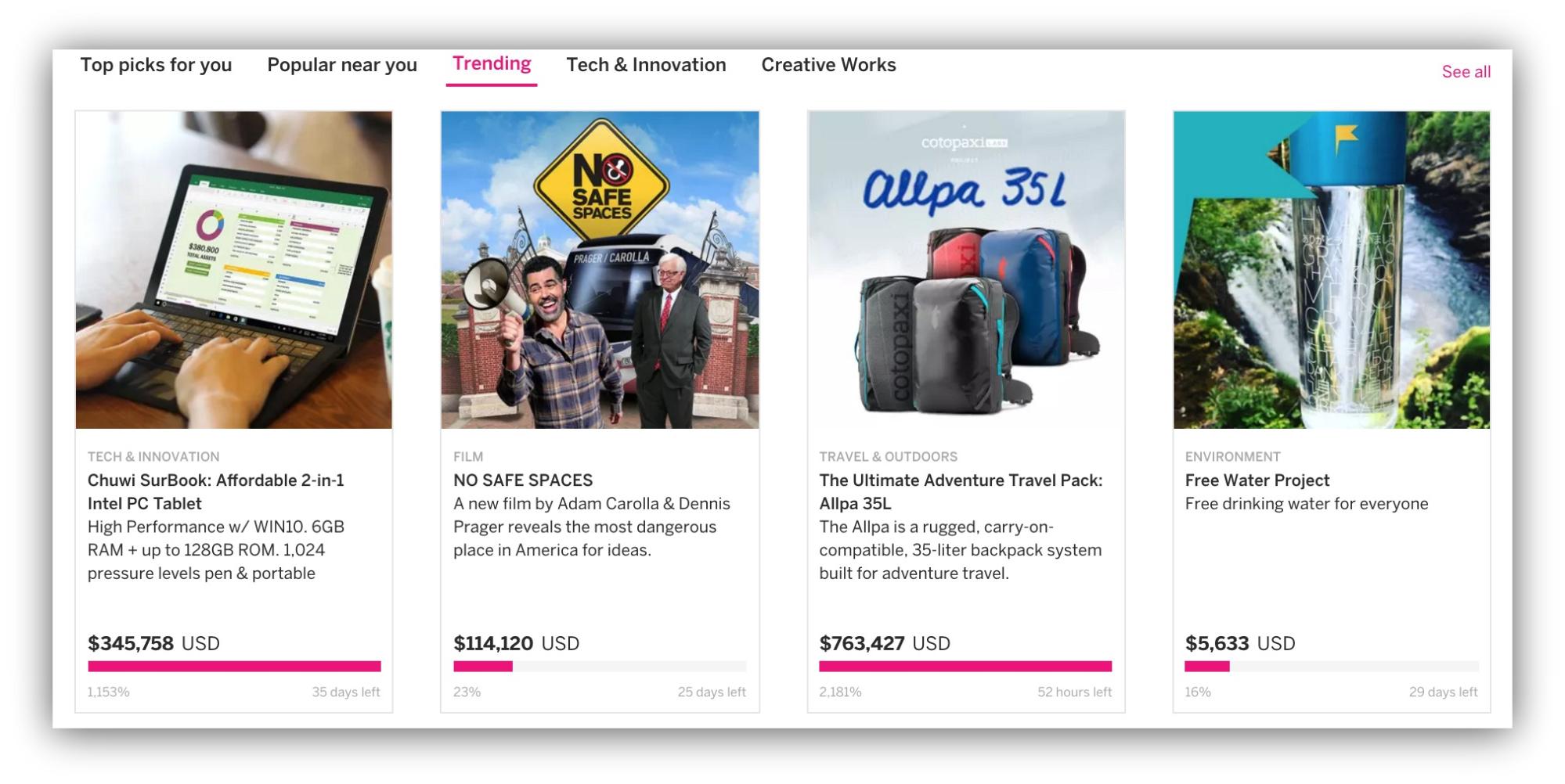
This is one thing I never considered working on during my first crowdfunding campaign. As a result, it failed miserably.
We raised $16,710, which sounds nice in theory, but our goal was $50,000. So the campaign was flagged “unsuccessful” which meant we didn’t cash a check at the bank and all of the money had to be returned.
Three months later, we relaunched the campaign and came back strong raising more than $592,566.
Wondering what I changed to see such an improvement? I mean, it was the exact same product in both rounds.

I paid way more attention to the popularity algorithm and focused on creating a big first launch day.
Here’s a snapshot comparison of the sales each campaign had 72 hours post-launch.
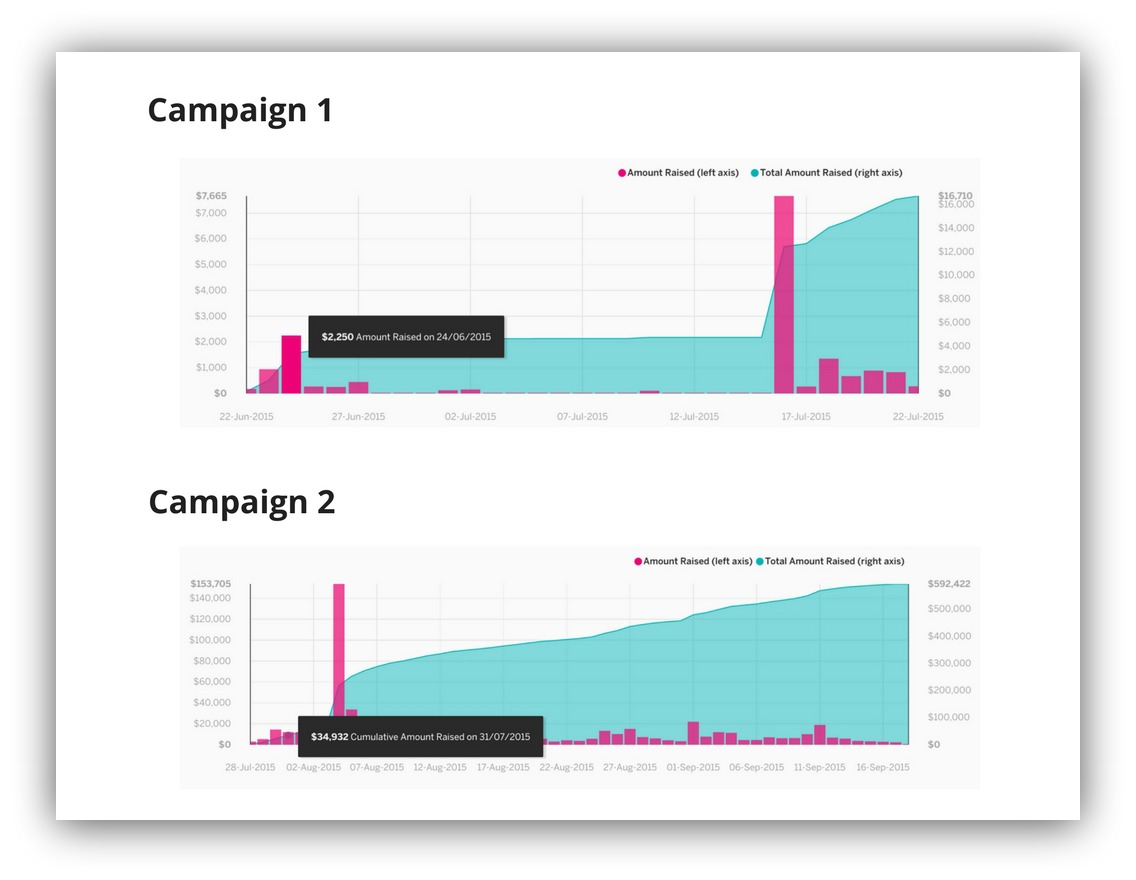
Thanks to focusing our attention on capturing early success and working that popularity algorithm, we were able to see such a drastic difference on our relaunch.
That large spike on the eighth day of the second campaign was when we raised $155K in 24 hours.
Because our campaign gained so much traction in a short amount of time, Indiegogo circulated us in their newsletter.
I quickly found out that when you’re one of the popular campaigns on their platform, they’ll happily promote you since it boosts the amount they make too. And in return, it helps you grab additional traffic.
So how can you ensure your campaign is just as popular?
The Magic Formula to Having a Successful Crowdfunding Campaign
Now that you understand the basics, it’s time to learn the strategy that catapults several successful crowdfunding product launches.
The Three Ingredients to Kickstarter Success
If you’re like my client Chris and are serious about pursuing your project, you can be successful too, but there’s a recipe you must follow.
And it comes down to three things:
- Create a product that people need and will pay for
- Launch to an audience of raving fans that are ready to buy your product
- Have a great product offer
You can’t have one without the other and all three must blend perfectly for success to happen.
#1: Create Something People Need (and They’re Willing to Pay For)
Don’t launch your product on a hunch that it will sell - prove it by getting to know your audience and asking for the sale.
Without knowing for sure whether your product will be successful, you may be wasting countless hours and thousands of dollars.
We’ve all seen it.
People think their dog or baby is the cutest thing in the world and you’re left wondering what they see.
Well, this same situation happens in business too.
We have a tendency to think our product is the best thing out there and that it’s as flawless as our baby.
Reality check: it might not be.
But when you’re so deep into launching your product, there’s a good chance you won’t see that.
So how can you avoid this situation?
Validate (& Sell) Your Product
You need to validate your product and make sure it will sell before you even think about hopping on a crowdfunding platform.
Product validation is the process of uncovering whether your product solves a problem in someone’s life so much that they are willing to pay for it.
So how do you do that?
Before you can find this answer, there’s a bit of homework to do.
First, you must identify who your customer is and really understand them completely.
To do this, create a one-page description of what your ideal customer looks like. This is known as a customer avatar or buyer persona.
Doing this exercise will help you hone in on who you want to target, why they would use your product, and where they hang out online.
Here’s why it’s important to get clear on this: These key details will help you find the right people to target to and help you craft a campaign that’s worth investing in their eyes.
If you don’t do this, you’ll end up creating a bland campaign that no one wants to invest in. And you’ll have to start from the ground up all over again.
To avoid this, answer the following questions related to your ideal customer:
- What is their story?
- Who are they?
- Are they married? Single?
- Where do they work?
- How old are they?
- Male or female?
- Why do they use your product?
- What are they struggling with that would make them want to buy your product?
Here’s an example of my perfect customer:
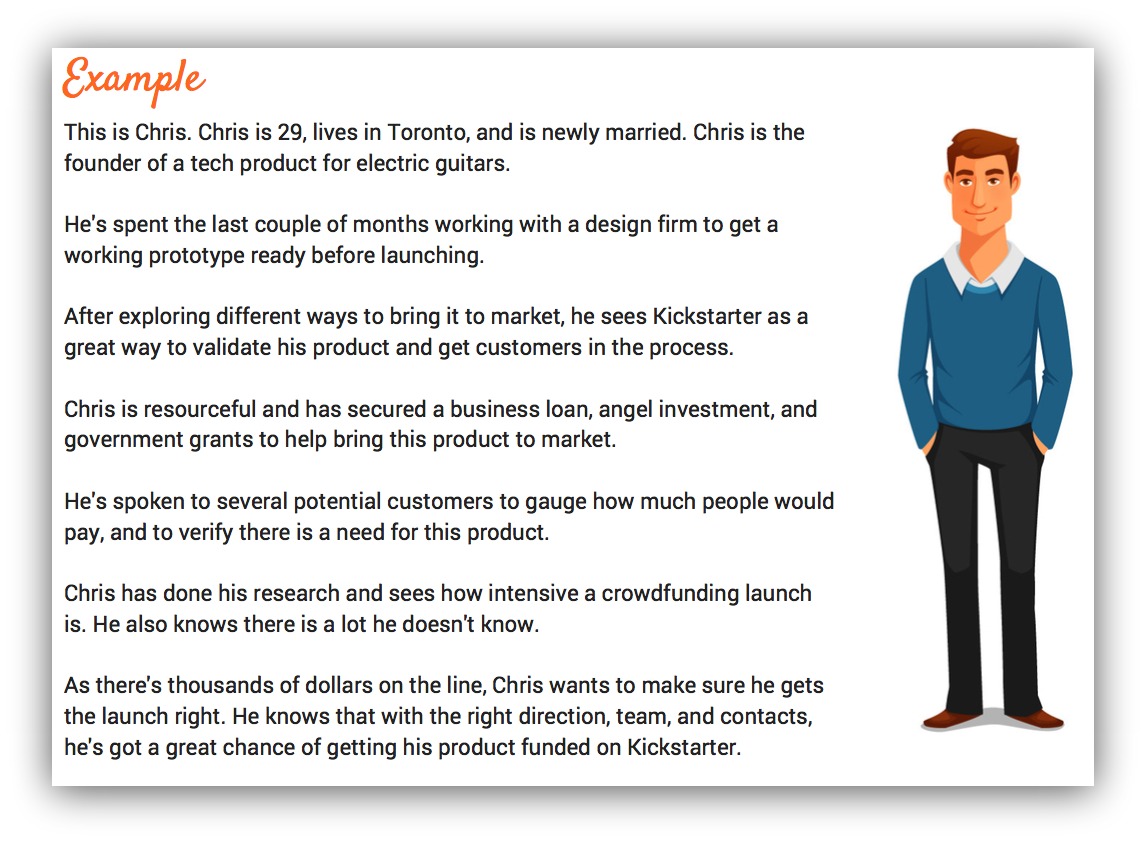
From experience, I’ve found that you need to:
- Give your customer a name
- Be specific
- Tell their story
Get inside their head as if you were writing the story as an existing customer.
So instead of just listing the qualities of your avatar, tell a story of what they were struggling with and why your product made an impact in their life as if it already happened.
If you’re struggling to uncover that last point, this next section will help.
Understand the Problem By Interviewing Your Target Audience
Great, so you’ve identified who your target customer is. Now you have to go out and get to know them.
Customer interviews are one of my favorite ways to do this. But I’m not going to sugarcoat this: They are a lot of work, but they’re certainly worth the effort thanks to the valuable insights you’ll uncover.
Specifically, interviews will help you understand exactly why someone would buy your product.
A few months ago, I made the mistake of not doing this. I assumed that I knew what my audience wanted because I had the credibility and a decent sized audience.
So I came up with a digital course based on my assumptions and went through the appropriate launch steps.
Guess how many courses I sold that day?
Zero.
But I did learn a ton and it’s one mistake I’ll never make again.
Now, I always ask my audience why they didn’t buy to understand their motivations on a deeper level.
In my case, it wasn’t the price, content, or even credibility.
Taking that information, I came up with a new offer and emailed my audience with a brief outline of what it was and asked them to set up a call with me if it was something they wanted to learn more about.
What happened next was unexpected.
I had over 50 people book calls with me to discuss this new product.
From this, I ended up launching the Crowdfunding Product Launch Academy and pre-selling over 25 spots before doors opened.
It worked because I understood exactly what my potential students needed and what they were willing to pay after I interviewed them.
Take note and don’t make this mistake like I did.
Interview people who fit your potential customer mold and don’t skip this step (no matter how uncomfortable it makes you).
To help you get started, use this next section.
Questions You Can Use to Interview Your Target Audience
In this recent Indiegogo campaign, I used the following interview questions:
- What is the most frustrating part about using your current earbuds?
- Can you tell me about the last time you tried to find a better solution?
- What solutions or other earbuds have you tried?
- What don't you love about the solutions you've tried?
- What did you love about the solutions you’ve tried?
In your case, you can drop everything related to earbuds and insert your project instead. Use it as a template and plug away.
Now, you may be thinking: what if I don’t have anyone in my network that fits my customer avatar? What should I do then? These interview questions won’t help.
And that’s only partially true.
Enter: online communities.
How to Use Online Communities To Survey Your Audience
Online communities are linked by common interests and demographics, so if you’re looking to find where your target market hangs out online, you’re in luck!
Think: Facebook groups, Reddit’s subreddits, and topic-specific forums.
To give you some more background, I’ll use an example.
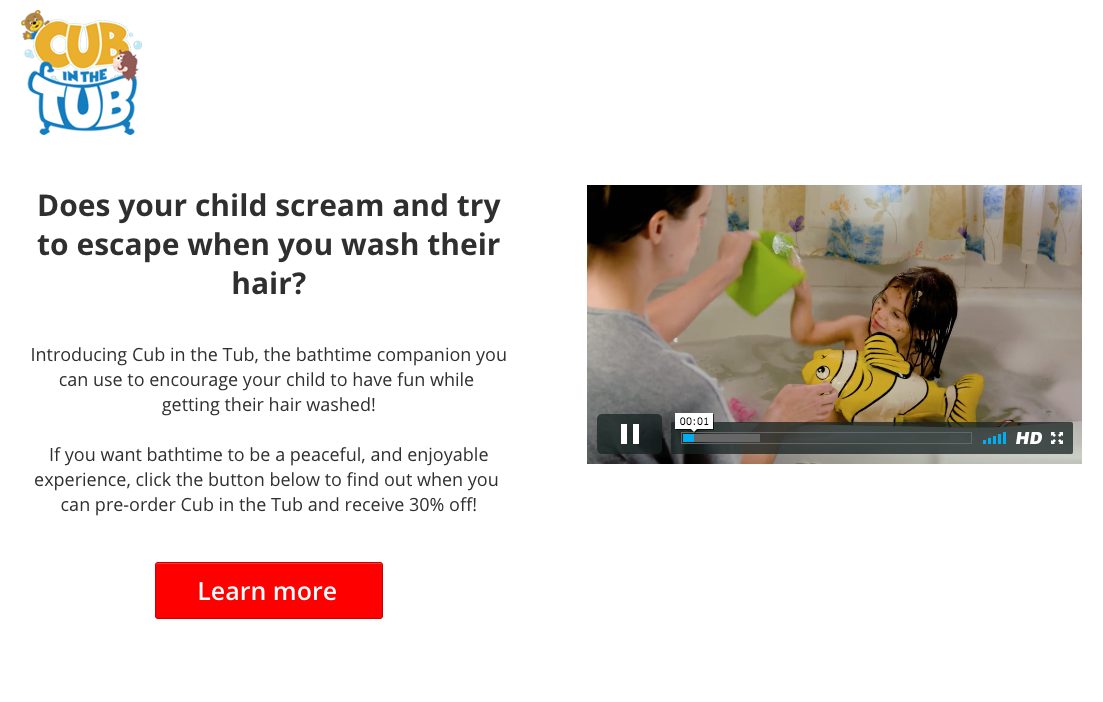
Cub in the Tub is a bathtime companion for kids who fuss when getting their hair washed.
So our target customer included Moms who struggled with this exact situation.
At the time, we were looking to find product testers who we’re willing to try the Cub with their kids.
So I scanned my network and found that I had a friend that ran a Facebook group for moms and I reached out.
I told her that I was looking for a couple of parents to try the product out, and asked if she wouldn’t mind posting something in the group.

She happily did and the post was a huge hit in the group.
Because of the high demand, we included a survey to filter out candidates by story.
Here’s a peek at the questions we asked using a Typeform survey:
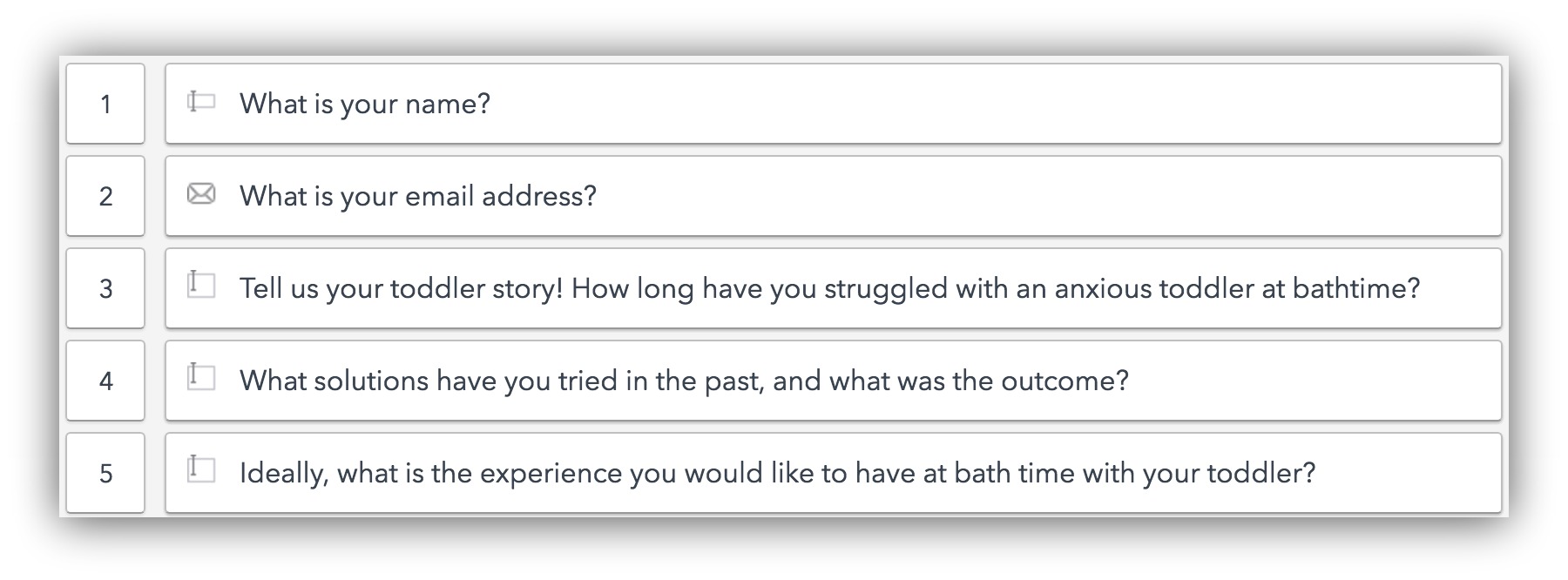
And here were some of the responses we received on the question: “How long have you struggled with an anxious toddler at bathtime?”
“He didn't mind water on his head too much until around 15 months. And now he screams and cries so intensely and so loudly that it still startles me. He's 30 mths now. I thought at first that it must have been the shampoo but we've tried Aveeno, Dr Bronner's, Burt's, Honest and he has the same response. I put my hand in front of his eyes, warn him to close his eyes, and tip his head back, but alas still the upset!”
And when asked what their ideal experience at bathtime is (after their problem is solved), here were a couple of the responses:
“I'd love to be able to wash her hair (maybe even use conditioner - crazy, I know) without her turning away and fighting me the whole time.”
Not only do online communities like this one allow you to get in front of your exact customers, but you’re able to really understand the specific problems they’re facing using the same words they’d actually use.
We can then use some of the phrases and keywords submitted from the survey on our landing page, in our videos, and any other marketing materials to really hit home with the messaging.
So when someone reads our marketing material, it’ll be as if we’re reading their minds.
We understand them that well.
In the Cub in the Tub example, it’s clear we have interest around the product but how can we be sure someone was willing to buy it?
After all, how many people will gladly sign up to be a product tester if that means they get the product for free?
Keep reading to find out...
Ask for the Sale and Make Sure a Stranger Will Buy Your Product
Your idea may be good and you may even find some interest in an online or in-person group, but that won’t mean a thing until you prove that someone is willing to pay for it.
In this guide, Justin Mares shows readers a few ways to ask for the sale when you don’t have a physical product yet.
Mares goes on to answer two key questions many product creators should also figure out before they plan a product launch:
“How many people want this product?" and, “Will they spend enough on the product that I can start a meaningful business?”
Kettle and Fire was validated from a poorly-designed landing page checkout site where Justin drove traffic to the page and tested if anyone would buy from there.
Notice how he didn’t do the easy “ask people in your network” thing? He wanted to see if strangers would buy the product.
And that’s key.
So when you’re getting ready to do your customer interview, remember that asking them if they will buy is not the same as getting a stranger to buy.
And by the way...
Validating Your Product Is Half the Battle
Sure, it’s a must-have first step, but it’s only half the puzzle really.
A quick Google search of ‘How to Kickstarter’ shows you pretty quickly that you won’t become a millionaire just by launching a project.
You realize that even with a validated product, you can still fail:
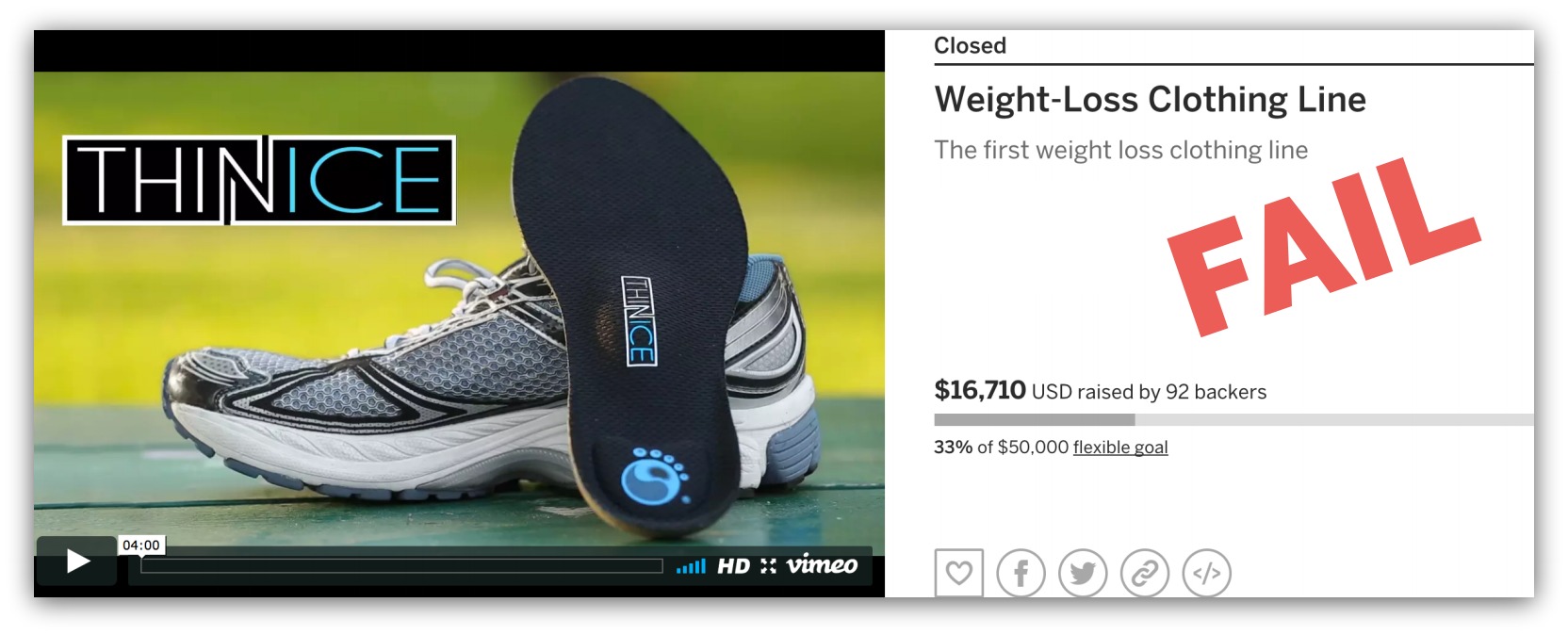
So the question is, what do you have to do to be successful and look like this?
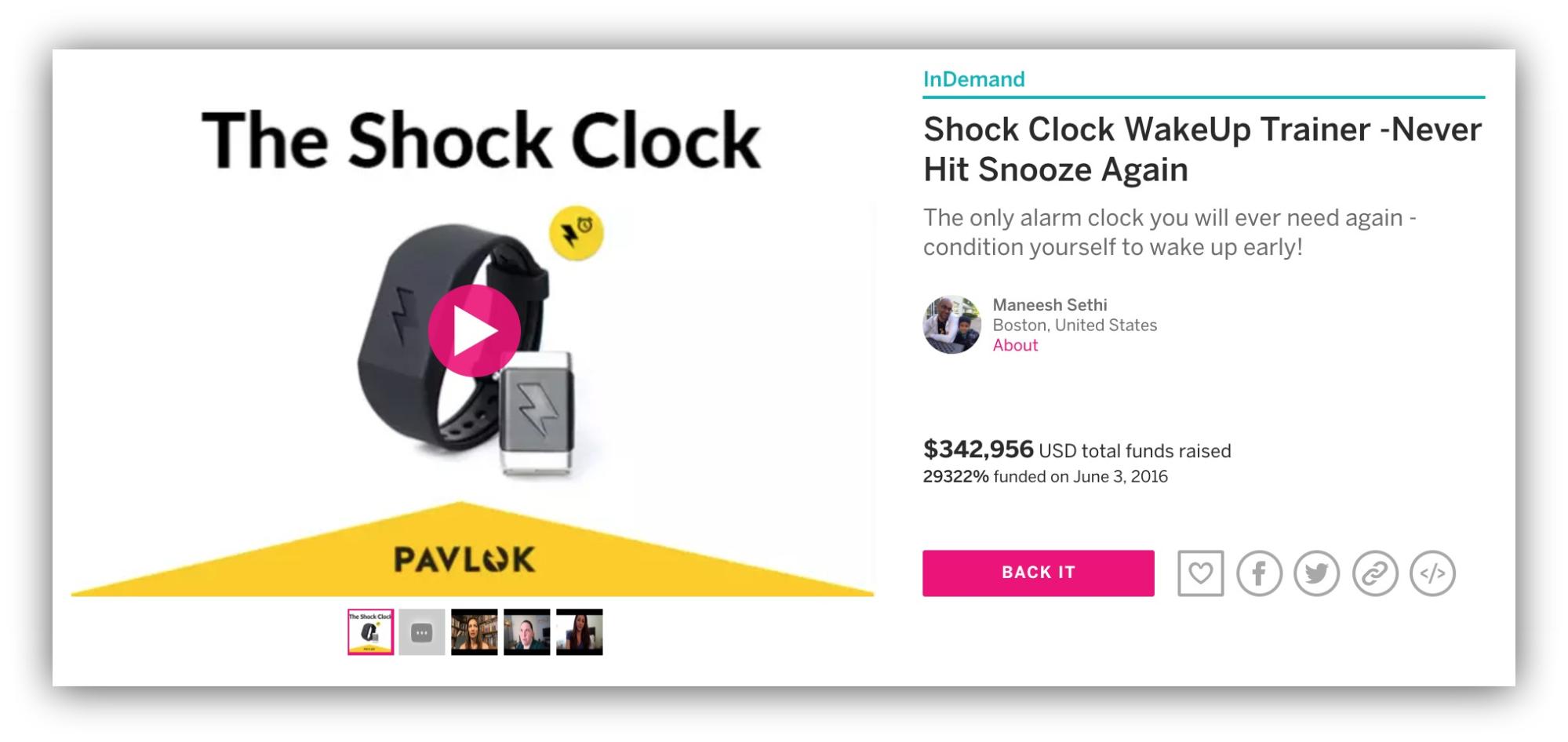
#2: Launch to an Audience of Raving Fans that are Ready to Buy Your Product
You also need to create momentum for your first big launch day.
And the best way to do this is to build an audience of raving fans.
They’ll be the ones to help you get that influx of sales in the first 24 hours. This kicks that Popularity Algorithm into gear and helps you rank on the site and get additional traffic from the platform.
But to get to this point, you need to build an email list (we showed you how to do that on this guide) and a private online community around your launch (you can find that guide here).
In both cases, you can drum up enough excitement pre-launch to give your launch day the boost it needs to reach the front page of your crowdfunding platform of choice.
And by offering your close-knit audience behind the scenes access to your campaign, you’re creating superfans who will not only translate into potential customers, but also customers for life. #DoubleWin
However, to really catapult your product to success, you need to have this next ingredient too.
How Big Does My Email List Need to Be Before Crowdfunding?
It’s not the size of your list that matters, but the quality.
The higher quality and more relevant your email list is to what you’re offering, the more excited your subscribers are going to be, and the more likely it is they’ll convert to sales.
Because the topic is so extensive and can’t be covered in the middle of this guide, check out this article when you’re done reading this.
Now, what if you have limited resources and can’t spend thousands of dollars building an email list?
Good news: you don’t have to.
Peter Li of Atlas Wearables chose to focus on quality of leads instead of building a huge list.
Nine months before Li and his team launched Atlas on Indiegogo, they attended events, meetups and conferences where their audience would be.
And it paid off big time.
They raised $638,029 without spending a dime on building their audience specifically.
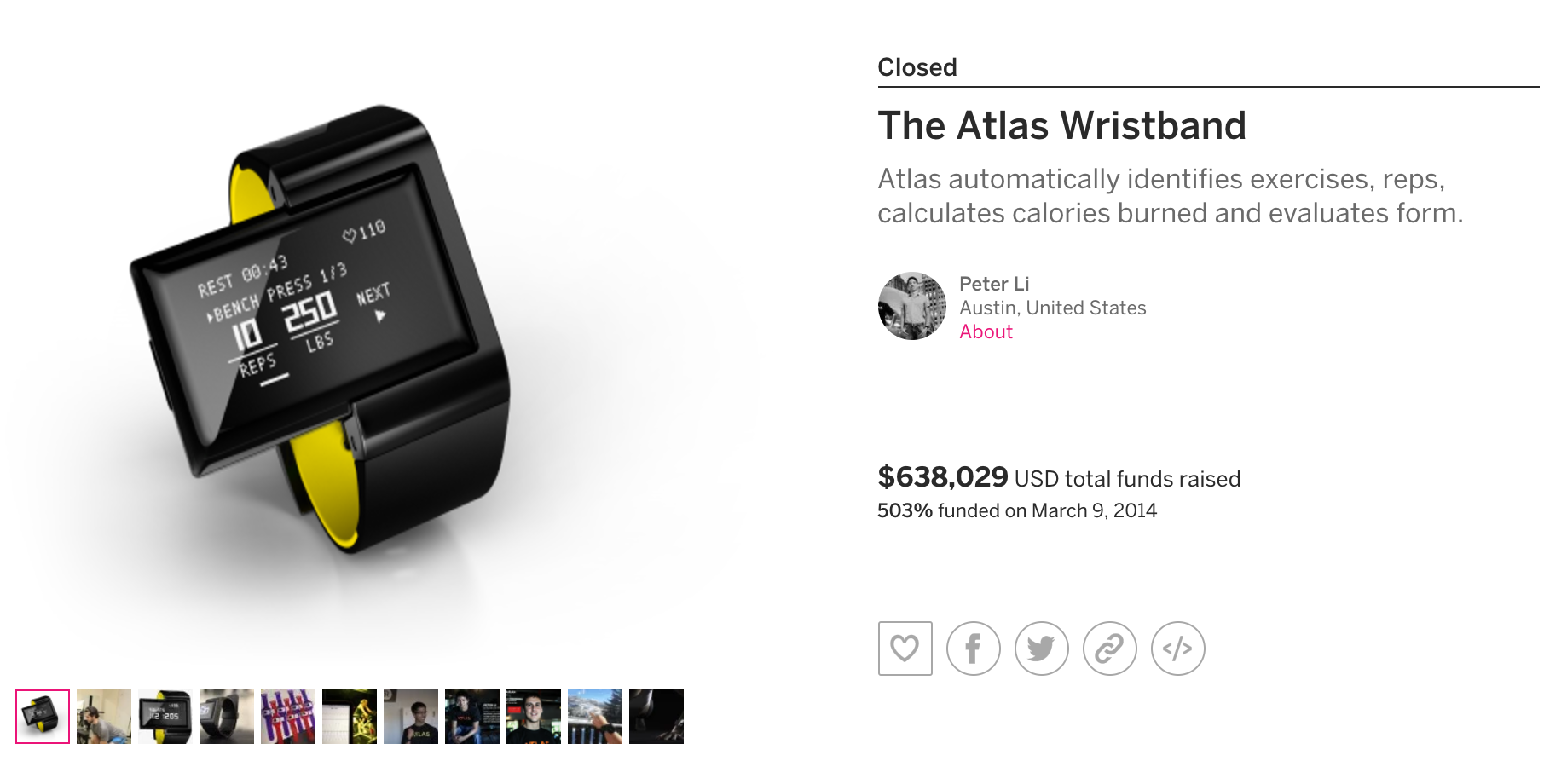
Why did this work so well for Li and his team?
They took advantage of the like, know and trust factor.
Not only did his potential customers know and trust Peter, but, thanks to his efforts, they were eagerly waiting for Atlas to launch on Indiegogo.
So while he only had a list of 1,000 subscribers before launching, his list included friends, family, and a network that was actually interested in what he had to offer.
You can learn from this exact strategy.
The Audience Building Hack (Aka How to Do More With A Smaller List)
Building an email list is so important because it’s a great way to develop a deeper relationship with potential customers.
But when you’re doing this months away from launch, how do you keep your list excited?
Build Your Own Online Community
While this route requires more legwork, it’s an effective way to keep your audience engaged and helps you understand them more. And, in both cases, that leads to more sales.
This exact method is what I used to raise over $15,000 in the first 4 hours of launching JamStack, and $28,939 in the first 24 hours of launching Foundr V1.0.
We created a closed Facebook group in both cases around our product launch and used that to share behind the scenes snippets of our campaign. We also used it as a way to get customer feedback.
You can use the poll feature or ask questions to gather votes on what features are most important to customers. This helps you build only the ones they’re looking for so you’re not wasting time on things you think your potential customer would want.
By giving our audience ownership of the product development process, they felt invested in the process. And it helped us give them exactly what they want. #DoubleWin
On top of that, it also helped us capture that early momentum that we desperately lacked in my first crowdfunding campaign launches.
Using Your Audience for Early Momentum
After validating your product and building an audience of raving fans around it, it’s now time to put all of this hard work together.
The goal of these strategies comes down to getting potential customers excited to buy on day one.
But this won’t happen without an incentive, or a really enticing offer.
This works great during the 10-14 day period before launching.
To do this, create an email sequence with a countdown and send it to your audience.
But this isn’t just any email sequence. Here, you must emphasize why potential customers should be excited and why their support on day one really matters.
You can do this by using this next technique.
The Black Friday Effect
Since the goal is to gain some major momentum in the first couple of days, you want to incentivize backers to support you as early on as possible.
A great way to do this is to create a huge amount of excitement on launch day by offering a limited number of early bird rewards. These should include drastically lower rates than you’d normally price things.
This gives early adopters the incentive to actually take action.
Plan these ahead of time and communicate them with your audience beforehand. It’s a surefire way to capture eager buyers before your campaign even launches.
That also leads us into my next point. No Black Friday sale is complete without an enticing offer.
#3: Have a great product offer
Notice the fine print: great product offer.
You can have a great product, but without understanding why it makes your customer’s life better and being able to communicate that, you won’t have any sales.
When we launched Thin Ice 1.0 and failed miserably (raising $16,710), we made the mistake of assuming we knew what the customer would value in our product.
We launched without speaking to a single customer, and, well, you can imagine how that turned out.
The traffic we did get didn’t convert at all.
After that campaign finished and we were preparing to relaunch, we discovered we alienated the very people we were hoping to sell to...yikes!
But this all came down to not testing our assumptions.
You know what the weird thing about assumptions are?
You have a 50% chance of being wrong.
Would you want to potentially lose out on thousands of dollars in sales because you were gambling on a hunch? I know I sure don’t.
To create a strong offer, make your way over to this guide when you’re done reading this.
But let’s say you use the tips in today’s guide and you still don’t gain the traction you were hoping for.
Does that mean you throw in the towel?
Not exactly..
Why We Relaunched and Doubled the Amount We Raised in 21 days
When you have a great product, and an audience, but you don’t have a full understanding of your customer and why they connect with your product, you can leave a lot of money on the table.
This was the case with JamStack.
As of writing this, we’ve raised, in total, $230,431. But what I didn’t mention, is we’re currently on our second crowdfunding.
Our first campaign launched on Kickstarter in November 2016 and we raised $81,811.
Now, we’re halfway through our Indiegogo campaign and so far we’ve raised over $149,099 with 1,055 backers.
In our case, JamStack had the audience, we even had a killer product. But our first campaign didn’t do as well as we hoped it would.
During the first campaign, we discovered that our audience converted fine, but we were having a hard time converting new, cold traffic.
Any new person that came to our Kickstarter page and watched the video, had a hard time fully connecting with the product.
When you get a new visitor to your website or your crowdfunding campaign page, you have a very short window to grab their attention and take action.
Hindsight is 20/20.
Companies that are on their second, or third crowdfunding launch tend to do better because they know their audience.
First time companies don’t have these audience insights and rely on guesswork.
So if you follow the tips today and still don’t see the insta-fame you were hoping for, don’t be afraid to roll up your sleeves and plan for a second (or third) re-launch. As long as you learn from your mistakes and make some tweaks moving forward, you’ll be in good shape.
Our decision to relaunch JamStack came from knowing we’d do better the second time with the information we received from our backers after the fact.
A lot of the data we collected was information we could have sourced before the first campaign, and we most likely would have gone on to raise a lot more on Kickstarter.
But because we didn’t get to know our audience ahead of time, we left a lot of variables up to chance and ended up not positioning the product as best we could.
The second time around we had the positioning on point and knew what features to emphasize based on the backer feedback we had.
This helped us launch and raise the funds we needed, even if it was through a second launch.
Create Your First Crowdfunding Campaign Today
Thanks to today’s guide, you have everything you need to create a successful crowdfunding campaign from the ground up.
Keep in mind, even if you don’t see immediate success on your first campaign, you can always re-launch a second or third time as long as you learn from your mistakes and make the necessary changes moving forward.
But, I want to see you succeed on the first try.
So to help you out, and so you can avoid a lackluster first launch, I’ve put together this helpful bonus resource.
BONUS Product Launch Checklist
I’m a huge fan of learning new stuff, but it wouldn’t be complete without giving you the TOOLS you need to actually do this.
Everything I’ve talked about in this guide is just the basics and the foundation you’ll need to lay in order to achieve success.
So to help you advance, I’ve created this free resource.
With this, you’ll receive:
- The Crowdfunding Product Launch Checklist
- The Ultimate Influencer Marketing Blueprint + Workbook
- Swipe files for welcome email sequences we use
- And more!
This bundle has everything you need to build an engaged audience and have a successful Kickstarter campaign...on the first try!
Grab Your Free Product Launch Toolkit


Comments